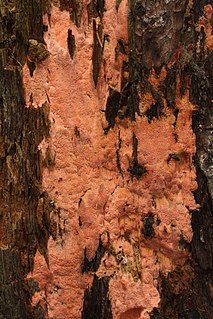
Karst is a topography formed from the dissolution of soluble rocks such as limestone, dolomite, and gypsum. It is characterized by underground drainage systems with sinkholes and caves. It has also been documented for more weathering-resistant rocks, such as quartzite, given the right conditions. Subterranean drainage may limit surface water, with few to no rivers or lakes. However, in regions where the dissolved bedrock is covered or confined by one or more superimposed non-soluble rock strata, distinctive karst features may occur only at subsurface levels and can be totally missing above ground.

The Hymenochaetales are an order of fungi in the class Agaricomycetes. The order in its current sense is based on molecular research and not on any unifying morphological characteristics. According to one 2008 estimate, the Hymenochaetales contain around 600 species worldwide, mostly corticioid fungi and poroid fungi, but also including several clavarioid fungi and agarics. Species of economic importance include wood decay fungi in the genera Phellinus and Inonotus sensu lato, some of which may cause losses in forestry. Therapeutic properties are claimed for Inonotus obliquus ("chaga") and Phellinus linteus, both of which are now commercially marketed.
Athroisma is a genus of plants in the family Asteraceae first described as a genus in 1833. It is native to East Africa and Madagascar.

Phanerochaete is a genus of crust fungi in the family Phanerochaetaceae.

Monotagma is a genus of plant in family Marantaceae described as a genus in 1902. It is native to tropical America.

The Meruliaceae are a family of fungi in the order Polyporales. According to a 2008 estimate, the family contains 47 genera and 420 species. As of April 2018, Index Fungorum accepts 645 species in the family.

Phlebia is a genus of mostly crust fungi in the family Meruliaceae. The genus has a widespread distribution. Phlebia species cause white rot.

Mycoaciella is a genus of corticioid fungi in the family Meruliaceae. The genus was circumscribed by John Eriksson and Leif Ryvarden in 1978. After microscopic examination of the three species then in the genus, Karen Nakasone proposed to synonymize Mycoaciella with Phlebia.

Sclerotinia is a genus of fungi in the family Sclerotiniaceae. The widely distributed genus contains 14 species.

Hyphoderma is a genus of crust fungi in the family Meruliaceae. It was circumscribed by German botanist Karl Friedrich Wilhelm Wallroth in 1833.

Hypochnicium is a genus of corticioid fungi in the family Meruliaceae. The genus was circumscribed by mycologist John Eriksson in 1958.

Steccherinum is a widely distributed genus of toothed crust fungi in the family Steccherinaceae.

Coniophora is a genus of fungi within the Coniophoraceae family. There are 20 species in the genus, which has a widespread distribution. One notable member is the cellar fungus (C. puteana), which causes wet rot in wood. Molecular analysis has revealed that there are cryptic species in the fungal lineages Coniophora olivacea, C. arida, and C. puteana.

Valencia is the only genus in the family Valenciidae. Valencia is a genus of ray-finned fishes. It is sometimes grouped into the family Cyprinodontidae. Members of this genus are restricted to southern Europe.
Fibriciellum is a fungal genus in the family Hydnodontaceae. The genus is monotypic, and contains one corticioid species, Fibriciellum silvae-ryae, found in Europe. The genus and species were described in 1975.
Chorigyne is a genus of plants first described as a genus in 1989. All the known species are native to Costa Rica and Panama.

Rhodonia is a fungal genus in the family Fomitopsidaceae. It is a monotypic genus, containing the single crust fungus Rhodonia placenta. A brown rot species, R. placenta is found in China, Europe, and North America, where it grows on decaying conifer wood.

Amphinema byssoides is a species of corticioid fungus known to form mycorrhizal relationships with spruce trees.
Haplobasidion is a genus of fungi belonging to the order Hypocreales, unknown family.
Intextomyces is a genus of fungi belonging to the family Hyphodermataceae.














